One of the things I am a real sucker for a rich and creamy Thai curry. The freshness of the herbs and spices used in Thai curries always intrigue me.. The first few times I made Thai curries at home, I went over to my local Asian market and grabbed a jar of curry paste. It turned out good but the heat in the curries, made with the store bought Thai curry paste was too much for my family.. It was just too spicy. That’s when I decided to do this myself, and now I am hooked!! My freezer is well stocked with all our favorite curry pastes..
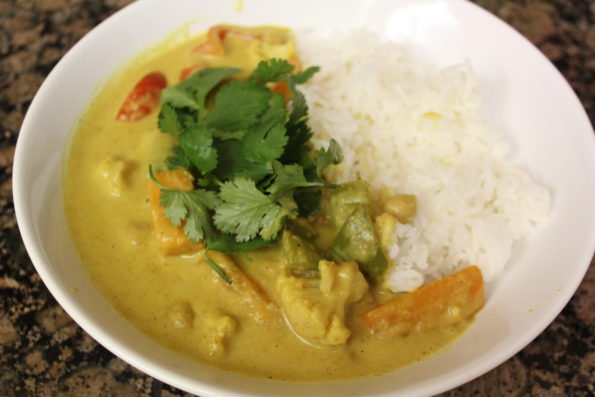
There are so many kinds of Thai curries, but basic ones you’d find at restaurants are Yellow, Green & Red curry. The easiest of the 3 kinds I’d say is the yellow curry (referred to as Kaeng Kari in Thai), you can even get away to making the paste without a visit to the Asian supermarket. Yup, for this yellow curry paste recipe, I use easy to find ingredients and it tastes delicious, just like the yellow curry you’d get in restaurants..
.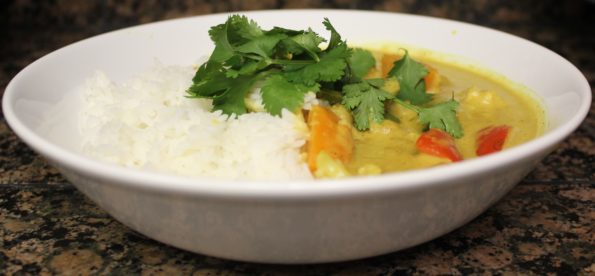
You say, why is it yellow? It’s the turmeric! And turmeric is so good for you, known for it’s amazing anti-inflammatory properties and calming powers. Ever wondered what makes your mustard yellow? yup, it’s turmeric..
This curry combines the spices and flavors of both Thai and Indian cuisines.. yummy! The Lemongrass in the curry is what gives it that Thai punch and trust me once you use this awesome flavor, you will go for it again, a little bit goes a long way with lemongrass. I have also started to use it in my marinades now..
Lemongrass is easy to find and is available in most of the larger grocery stores. Lemongrass is sold as stalks and you will need a few for this recipe. If you haven’t had a chance to experiment with lemongrass before, we will only use the inner soft portion on the bottom. You would end up discarding most of the outer thick stalk. This layer is tough and has no flavor, more over, for this recipe, if used you’d have a hard time grinding it up in the processor when making your paste.
In addition to preparing the lemongrass, dice up a red onion, about 10 cloves of garlic and 5-6 inch piece of ginger.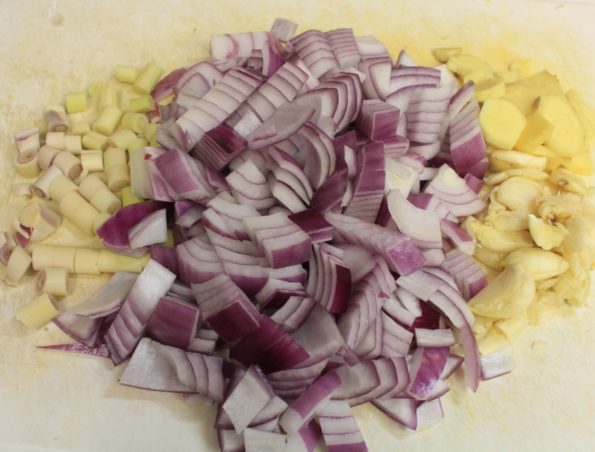
Heat up ¼ cup of vegetable oil and sauté the onion, garlic, ginger and lemongrass these until they are translucent. Add 3 tbs of turmeric and 5tbs salt and saute for few more mins stirring frequently. Now add 2 red chilies, 2-3tbs mild curry powder & 2tsp coriander power and sauté couple more mins. You can use any type of Curry Powder you find. I usually keep a jar of the curry powder handy at home.
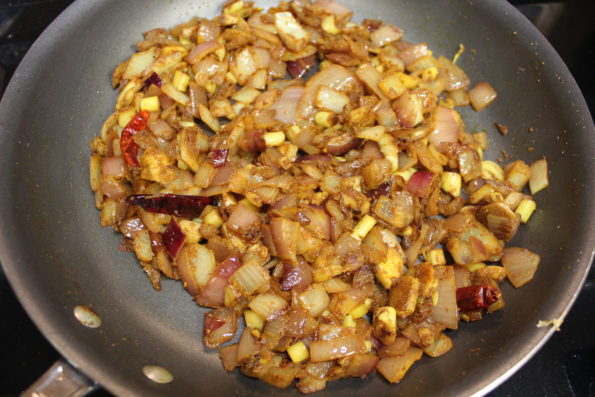
Add the entire mixture to the food processor and then add ½ cup of packed cilantro + stems if using. Run the food processor until the mixture forms a smooth paste. You may need to add some water to get the processor going. Add 1 tbs of water at a time, you only want to add enough water to help the processor along. The paste would be smoother with the least amount of water. Adding too much water will end up making the paste grainy. The key is to add 1 tbs of water at a time. The processing may take some time, be patient. The smoother the paste, the creamier the curry. You can use your finger tips to feel the paste for the texture, if not very smooth then run the processor longer..
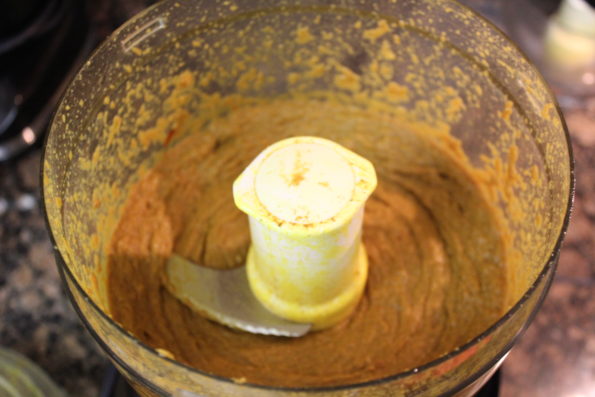
I usually tend to double up the recipe and save the curry pastes in the refrigerator or freezer for a couple more dinners. You can change up the protein and vegetables in the other 2 dinners. The paste also makes for a great marinade for chicken or beef.
The best way to freeze the curry paste is in ice cube trays. Once frozen, pop all the curry cubes into a freezer ziploc and you can use the cubes as you need.
The Curry..
The main requirements to any Thai curry:
Coconut Milk + Curry paste + the Protein + Vegetables
For the Coconut Milk, I like going for the full fat cans of coconut milk, makes the curry so creamy and rich. If you like you can go for the light coconut milk, but I find it waters down the curry, so I’d say let’s do this right and go for the original coconut milk. Any brand really is just fine, I just buy them in bulk at on Amazon or sometimes Costco carries them in bulk as well.
Paste, we will use our delicious yellow curry paste we have made above. You can also make the paste ahead of time and freeze it. When it come time for the curry, we take out our curry cubes and pop it into the coconut milk.
Ah, for the protein and vegetables, so many combinations, you can go nuts with your imagination. Here are some of my favorites:
Option 1: Butternut squash, Cauliflower, Red Bell Pepper, Green Bell Pepper, Chickpea
Option 2: Potatoes, Chicken, Red Bell Pepper, Cauliflower
Option 3: Tofu, Eggplant, Red Bell Pepper, Potatoes
I will be using Option 1 for this recipe, it is so different and opens up a new world for butternut squash usage. I would recommend using fresh butternut squash, you can either buy the whole squash and cut it up or buy pre-cut cubes. But do not use frozen squash, freezing the squash changes the texture and it doesn’t hold together in the curry, falls apart as it warms up and you end up with a mush. For the chickpea, the canned chickpeas works perfectly well.
To make the curry, dice up the vegetables to desired size and sauté in 2-3tbs oil until they start to soften and take them out.
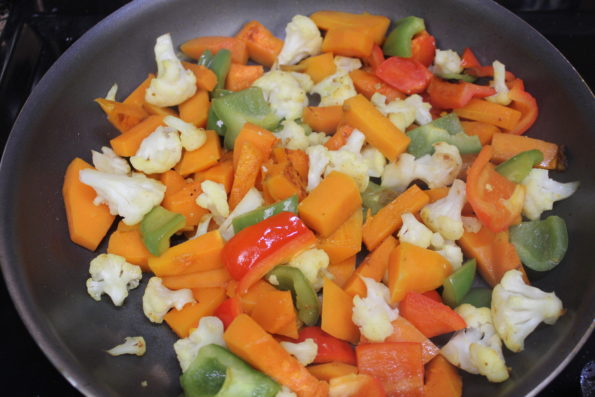
In the same pan bring 2 cans of coconut milk to boil, add 1 cup of the yellow curry paste and stir to combine. Simmer this mixture for 15-20 mins until the curry paste is well incorporated into the coconut milk.
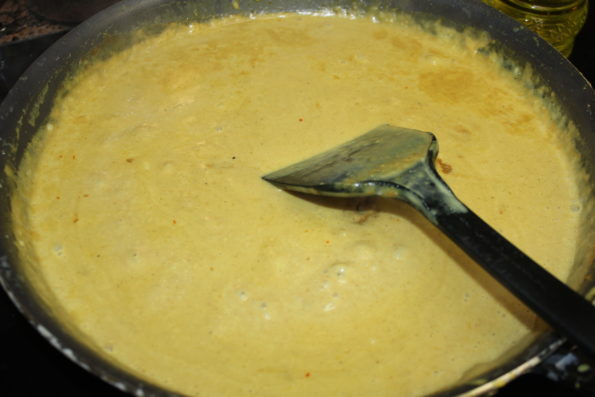
Add 1 can of chickpea and the cooked vegetables to the curried coconut milk and simmer for another 10 mins. Garnish with green onions and cilantro! Serve it over warm Jasmine Rice!
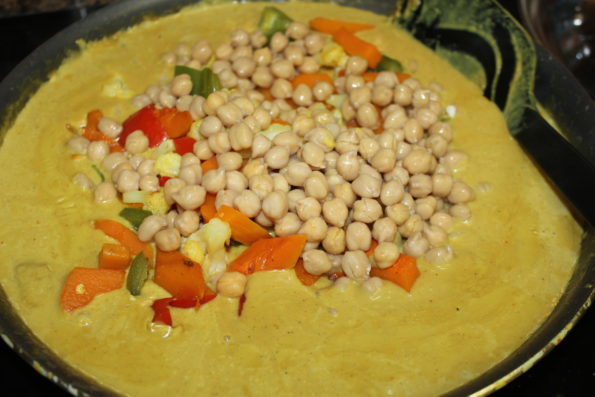
This curry has quickly become our go to comfort food especially on a cold winter day. Hope you enjoy it as much as we do!

Here is the recipe.
- 1 large Red Onion
- 10 cloves of Garlic
- 5 to 6 inch piece of Ginger
- 1 to 2 dry Red Chilies (4-5 for spicy version)
- 1.5 tbs Salt
- 2-3 Tbs Turmeric
- 2-3 Tbs Mild Curry Powder
- 2 tsp roasted Coriander Powder
- 2-3 lemon grass stalks
- 1 cup packed cilantro leaves and stems (optional)
- Chop up the 1 large Red Onion, 10 cloves of Garlic and 5-6inch piece of Ginger
- Peel the 3 Lemongrass stalks and dice the inner softer lighter part of the stalk.
- Heat about ¼ cup olive oil in a sauté When hot add the chopped onion, garlic, ginger and lemongrass.
- Add the 2 Red Chilies, 2-3Tbs Mild Curry Powder & 2Tsp Coriander Power and sauté couple more mins.
- Add the entire mixture to the Food Processor and then add the Cilantro and Stems if using. Run the food processor until the mixture forms a smooth paste. You may need to add some water to get the processor going. Add 1 tbs of water at a time, you only want to add enough water to help the processor along. The paste would be smoother with the least amount of water. This step may take some time. You your finger tips to feel the paste for the texture, if not very smooth then you will need to run the processor longer.
- 2 Cups of Chopped Butternut Squash
- 1 Cup of Green Bell Pepper
- 1 Cup of Red Bell Pepper
- 2 Cups of Cauliflower
- 1 Can of Chickpeas
- 2 Cans of Coconut Milk
- 1 Cup of the Yellow Curry Paste
- Chop the vegetables to the desired size.
- Heat about 2-3 of oil in pan and sauté the vegetables until they start to soften.
- Remove the vegetables from the heat
- In a large sauté pan, bring to boil 2 cans of Coconut milk
- Add 1 cup Yellow Curry paste and whisk to combine
- Simmer the mixture for about 15 to 20 mins until the curry paste is well incorporated into the coconut milk.
- Add 1 can of Chickpea and the cooked vegetables to the curried coconut milk and simmer for another 10 mins.
- Add chopped Green onion or Cilantro for Garnish.
- Serve with white Jasmine rice.
Looks yummy!!!!
Thanks :)!
This looks delicious! I have got to make this for my Dad.
Looks amazing! I’ve never even considered making my own curry paste. I’ll have to try making my own for that Panang Curry Soup I like to make.